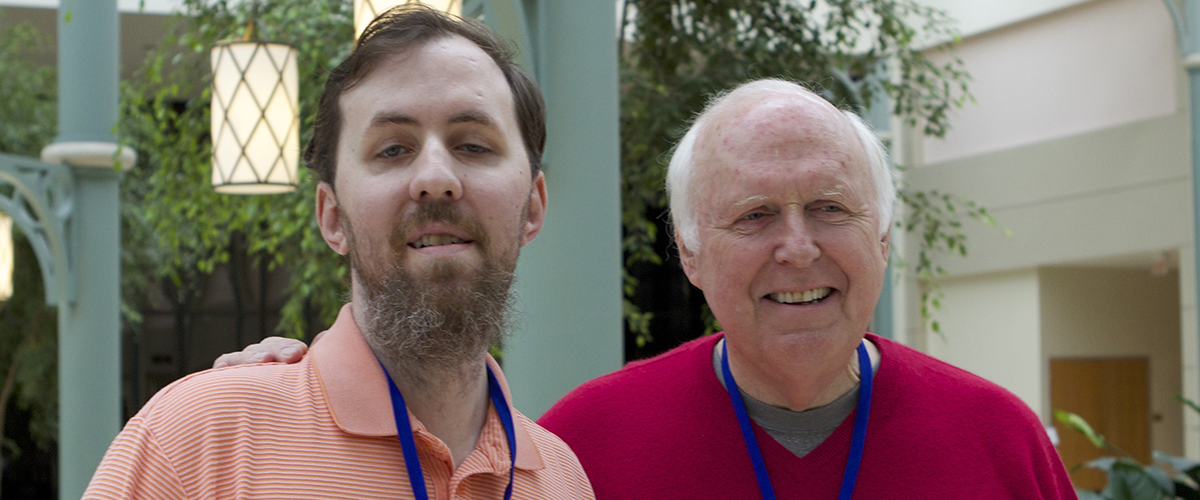Although the nature and locations of the repeat expansions are different for DM1 and DM2, the underlying molecular mechanism, sequestration of MBNL and consequent missplicing of a wide range of transcripts, is ostensibly the same. It then begs the question, why are the phenotypes of DM1 and DM2 different?
Understanding Molecular Mechanisms in DM1 and DM2
One “logical” interpretation for the milder phenotype in DM2 is that CCUGexp repeats may be less toxic. Perhaps MBNL is not sequestered as efficiently by DM2 repeats (hence DM2 patients typically have much longer repeats) and thus not depleted to the same extent as in DM1. But there are many potential alternative hypotheses, including differences due to the genomic locations of the expanded repeats or the presence of as yet unknown modifiers that act upon the expanded repeat transcript or other potential targets upstream of the ensuing splicing anomalies.
Drs. Beatriz Llamusi (University of Valencia) and Nicolas Charlet-Berguerand (Université de Strasbourg) and colleagues have identified an RNA binding protein that acts to reduce MBNL depletion in DM2, but not in DM1. Their data suggests a molecular explanation that, at least in part, reconciles the phenotypic differences between DM1 and DM2.
rbFOX1 binds CCUGexp, but not CUGexp RNA
To assess whether alternative RNA binding proteins may be more efficient at binding to CCUGexp versus CUGexp, and thereby mitigate MBNL sequestration in DM2, the research team conducted an unbiased assay for C2C12 cell nuclear extract interactions with the two expanded repeat sequences. They identified several proteins that bound to the expaned repeat sequences, but, among the hits, only rbFOX family RNA binding proteins interacted with CCUGexp, but not CUGexp. They further showed that rbFOX1 localizes to nuclear foci only in cells containing the DM2 repeats.
The research team them utilized gel-shift and UV-crosslinking experiments to demonstrate the mechanism by which rbFOX1 is retained in nuclear foci containing CCUGexp sequences—these studies confirmed a direct interaction between rbFOX1 and CCUGexp.
rbFOX1 is Bound to CCUGexp in DM2 Patient Cells
In additional experiments, the research team established that rbFOX1 co-localized with CCUGexp–containing foci in primary muscle cultures derived from DM2 patients, as well as in sections from DM2 patient skeletal muscle. Yet, additional studies showed that rbFOX1 was not immobilized in CCUGexp RNA foci in the same manner as MBNL. rbFOX1 was not detected in similar nuclear analysis of DM1 patient cells or tissues.
Excess rbFOX1 Displaces MBNL from CCUGexp and its Overexpression Corrects Splicing and Muscle Atrophy
Although rbFOX1 and MBNL both bind CCUGexp, their interactions may or may not be competitive. But, expression of an excess of either rbFOX1 or MBNL was shown to compete the other away from binding to the DM2 expanded repeat; depletion of rbFOX1 increased the localization of MBNL to CCUGexp. These data are consistent with the hypothesis that rbFOX1 and MBNL compete for the same binding site.
The next step was to test whether an overabundance of rbFOX1 could mitigate the downstream effects of MBNL depletion. Overexpression of rbFOX1 in C2C12 cells carrying CCUGexp resulted in partial correction of splicing of Clcn1 and Tnnt2 mini-genes, while reduction of rbFOX1 by siRNA increased the splicing defect. Finally, the research team overexpressed rbFOX1 in Drosophila models of DM1 and DM2 and showed rescue of skeletal muscle atrophy only in the DM2 model.
Taken together, the investigators here provide a molecular model to explain, at least in part, the phenotypic differences between DM1 and DM2. Reduced sequestration of MBNL by CCUGexp versus CUGexp repeats by rbFOX1 would mitigate the splicing defects and thereby potentially contribute towards the milder pathology in DM2.
Reference:
rbFOX1/MBNL1 competition for CCUG RNA repeats binding contributes to myotonic dystrophytype 1/type 2 differences.
Sellier C, Cerro-Herreros E, Blatter M, Freyermuth F, Gaucherot A, Ruffenach F, Sarkar P, Puymirat J, Udd B, Day JW, Meola G, Bassez G, Fujimura H, Takahashi MP, Schoser B, Furling D, Artero R, Allain FHT, Llamusi B, Charlet-Berguerand N.
Nat Commun. 2018 May 22;9(1):2009. doi: 10.1038/s41467-018-04370-x.

